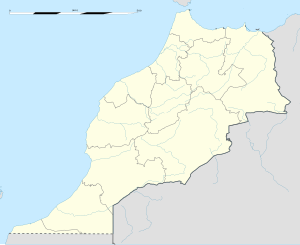world.wikisort.org - Morocco
Tafilalt or Tafilet (Berber languages: ⵜⴰⴼⵉⵍⴰⵍⵜ; Arabic: تافيلالت), historically Sijilmasa, is a region and the largest oasis in Morocco.[2]
Tafilalt
Tafilalt / ⵜⴰⴼⵉⵍⴰⵍⵜ / تافيلالت | |
|---|---|
Region | |
 Panorama of the oasis of Tafilalet, seen from the ksar of Tingheras (Rissani). | |
 Tafilalt Location in Morocco | |
| Coordinates: 31°20′22.43″N 4°16′5.48″W | |
| Country | |
| Region | Drâa-Tafilalet |
| Time zone | UTC+1 (CET) |
| Designations | |
|---|---|
Ramsar Wetland | |
| Official name | Oasis du Tafilalet |
| Designated | 15 January 2005 |
| Reference no. | 1483[1] |

Etymology
The word "Tafilalt" is an Amazigh word and it means "Jug", which is specifically a pottery jar used to store water.[3]
History
Although previous settlements existed, especially during the Roman period, the first continuously inhabited town in the area after the spread of Islam was Sijilmasa, founded by the Amazigh Miknasa tribal leader Moussa ben Nasser in 757 CE.[4] It was on the direct caravan route from the Niger river to Tangier, and attained a considerable degree of prosperity.[5][6] In the 17th century, the Alaouite dynasty of Morocco first achieved political ascendancy in Tafilalt, and in 1606 the Sultan Zidan al-Nasir hid in Tafilalt, where he made a profit off of gold mined in the area, built an army, eventually taking control of the city of Marrakech. A few years later in 1610, Ahmed ibn Abi Mahalli also built up an army in the Tafilalt area and took Marrakech back for himself, but lost control after Sidi Yahya ben Younes liberated the city for al-Nasir. A decade after this, a revolutionary movement arose in Tafilalt against the ruling sultan, but was repressed after four months of skirmishes. Later, Tafilalt was a major center of the Dila'ites.[7] In 1648, a custom was established by Moorish sultans of Morocco sending superfluous sons or daughters who would not inherit titles or power to Tafilalt.[5]
Medieval traveller Ibn Battuta wrote about visiting Sijilmasa (near Tafilalt) in the fourteenth century on his journey from Fez to Mali, "the country of the blacks".[2] It was later destroyed in 1818 by the Aït Atta, but its ruins remain, including two gateways.[8] The first European to visit Tafilalt in the modern era was René Caillié (1828), and later Gerhard Rohlfs (1864).[9][5] English writer W. B. Harris described Tafilalt in a journal after his visit.[10]
Geography
Entirely located along the Ziz River,[11] the oasis was, before mechanized transport, ten days' journey south of Fez and Meknes, across the Atlas Mountains.[2] It is known for its dates.[10]
Notable residents
It is the birthplace of the famed Rabbi Israel Abuhatzeira, known as the "Baba Sali" (Arabic: بابا صلى, Hebrew: באבא סאלי, lit. "Praying Father"), (1889–1984).[12]
In literature
Mercenaries of Hell (original title Pokol zsoldosai), a novel by the famous Hungarian author Jenő Rejtő takes place in the village and surrounding area.[13][circular reference]
References
- "Oasis du Tafilalet". Ramsar Sites Information Service. Retrieved 25 April 2018.
- Michael Dumper; Bruce E. Stanley (2007). Cities of the Middle East and North Africa: A Historical Encyclopedia. ABC-CLIO. p. 336. ISBN 978-1-57607-919-5.
- Chafik, Mohammed (1990). المعجم العربي الأمازيغي. Morocco: أكاديمية المملكة المغربية. p. 217 – via scribd.
- Everett Jenkins Jr. (1 October 1999). The Muslim Diaspora (Volume 1, 570-1500): A Comprehensive Chronology of the Spread of Islam in Asia, Africa, Europe and the Americas. McFarland. p. 57. ISBN 978-0-7864-4713-8.
- One or more of the preceding sentences incorporates text from a publication now in the public domain: Chisholm, Hugh, ed. (1911). "Tafilált". Encyclopædia Britannica. Vol. 26 (11th ed.). Cambridge University Press. p. 354.
- Julius Honnor (2012). Morocco Footprint Handbook. Footprint Travel Guides. p. 195. ISBN 978-1-907263-31-6.
- Aomar Boum; Thomas K. Park (2 June 2016). Historical Dictionary of Morocco. Rowman & Littlefield Publishers. p. 453. ISBN 978-1-4422-6297-3.
- Lonely Planet; Paul Clammer; James Bainbridge (1 July 2014). Lonely Planet Morocco. Lonely Planet Publications. p. 329. ISBN 978-1-74360-025-2.
- Samuel Pickens; Michel Renaudeau; Xavier Richer (1993). Le Sud marocain. www.acr-edition.com. p. 152. ISBN 978-2-86770-056-9.
- Ronald A. Messier (19 August 2010). The Almoravids and the Meanings of Jihad. ABC-CLIO. p. 198. ISBN 978-0-313-38590-2.
- Ronald A. Messier; James A. Miller (15 June 2015). The Last Civilized Place: Sijilmasa and Its Saharan Destiny. University of Texas Press. p. 53. ISBN 978-0-292-76667-9.
- Marek Čejka; Roman Kořan (16 October 2015). Rabbis of our Time: Authorities of Judaism in the Religious and Political Ferment of Modern Times. Taylor & Francis. p. 33. ISBN 978-1-317-60543-0.
- "A pokol zsoldosai". Wikipédia (in Hungarian). 23 September 2018.
Further reading
- Harris, Walter B. (1895), Tafilet; The Narrative of a Journey of Exploration in the Atlas Mountains and the Oases of the North-west Sahara, Edinburgh: W. Blackwood and Sons.
External link
![]() Media related to Tafilalt at Wikimedia Commons
Media related to Tafilalt at Wikimedia Commons
На других языках
- [en] Tafilalt
[es] Tafilálet
Tafilálet (en árabe, تافيلالت, en lenguas bereberes, ⵜⴰⴼⵉⵍⴰⵍⵜ) históricamente conocido como Siyilmasa, es un oasis y una región histórica en el sureste de Marruecos atravesada por el río Ziz. Corresponde a la Provincia de Errachidía. Las ciudades más importantes del Tafilálet son Erfud y Rissani.Другой контент может иметь иную лицензию. Перед использованием материалов сайта WikiSort.org внимательно изучите правила лицензирования конкретных элементов наполнения сайта.
WikiSort.org - проект по пересортировке и дополнению контента Википедии